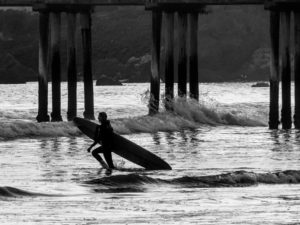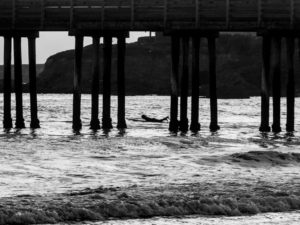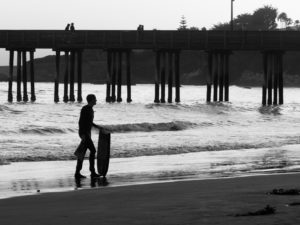Buildings. I love them. I love their form, their function, their stories, and their history. This was one of the tougher edits as far as choosing what to share. Architecture in the south and east is so very different than what we have out west, especially in New Orleans. I couldn’t get enough.
But first! a quick word about keywords. I changed one of my main themes from architecture to buildings and here’s why: buildings, in my mind, is a broader subject. It includes, for me, all things built by humans. It could be a pool, a bridge, homes, skyscrapers, windows, doors, door knobs, gates, fences, and the like. Those are actually some of my keywords under buildings. Here are all nine of them: doors, windows, interior, brick, church, gate, historic, stone, and house. I’m not sure I’m married to this list and it will change as my subject choices change, but that’s what I have at this point in time.
Beyond the main theme, you could honestly just keep going with subsets. For example, one could pull up all church images, change the preset to churches and continue to add keywords like steeple, stained, glass, pews, altar, religious, etc.
Our first stop on our adventure was with some old, dear friends in Portal, AZ. We stayed in our camper, and they slept in the yurt. We ate and lounged in the yurt as well. We cooked and used the bathroom in the tiny house on the right, which is hooked up to a cistern and a septic tank.
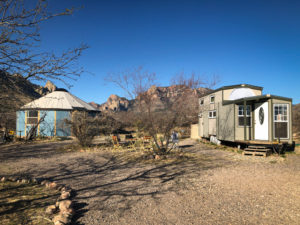
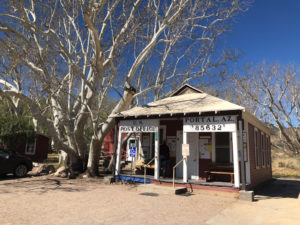 Portal is an unincorporated community in Cochise County, in southeastern Arizona. We got off I-10 and drove 25 miles south-southeast of San Simon on the east side of the Chiricahua Mountains. This area is often called the Yosemite of Arizona. The community is also a popular location for birding.
Portal is an unincorporated community in Cochise County, in southeastern Arizona. We got off I-10 and drove 25 miles south-southeast of San Simon on the east side of the Chiricahua Mountains. This area is often called the Yosemite of Arizona. The community is also a popular location for birding.
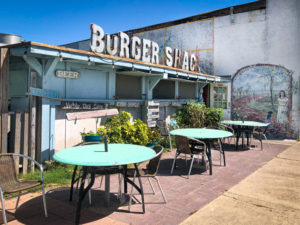
One of our Harlingen, TX days was spent in South Padre Island. To get there we had to drive through Port Isabel, part of the Brownsville–Harlingen–Raymondville – Matamoros metropolitan areas. Established as a town after the Mexican War of Independence, Port Isabel became an important cotton-exporting port before the American Civil War. The harbor, town, and lighthouse all were fought over and exchanged hands during the Civil War.
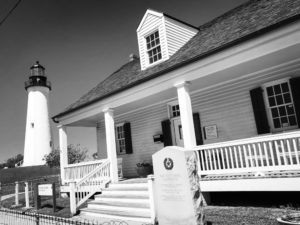
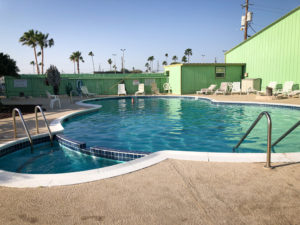 This is the pool at our funky RV park in Walasco. It was heaven. We mostly had it to ourselves as most park inhabitants had already fled the heat and gone back to Canada.
This is the pool at our funky RV park in Walasco. It was heaven. We mostly had it to ourselves as most park inhabitants had already fled the heat and gone back to Canada.
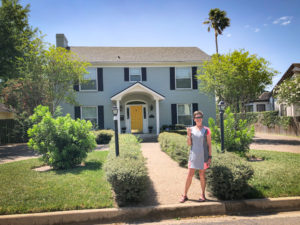 This is Ellen’s childhood home. The owners were SO lovely and let us come in a poke around. Ellen shared childhood stories she could recall and it was fun to listen to how the house USED to be when she was a kid.
This is Ellen’s childhood home. The owners were SO lovely and let us come in a poke around. Ellen shared childhood stories she could recall and it was fun to listen to how the house USED to be when she was a kid.
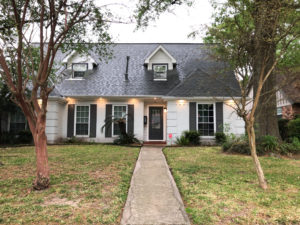
This is cousin David’s home in Houston. He does a lecture series at Rice University when he is in town, exercising the mind you know, and we joined him. I could have done a whole blog alone on the architecture of Rice University.
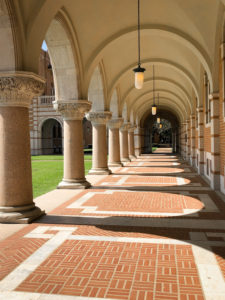
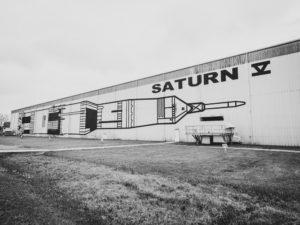 On our way to Galveston, we couldn’t pass up the Johnson Space Center. We did a tour of the grounds and drove by this building that still contains a Saturn V rocket. It was really long.
On our way to Galveston, we couldn’t pass up the Johnson Space Center. We did a tour of the grounds and drove by this building that still contains a Saturn V rocket. It was really long.
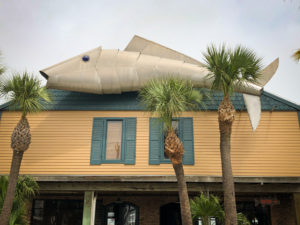 On to Galveston. The above image had three main theme hits, animals, art, and buildings. I chose to share it in buildings. I believe this was part of a restaurant.
On to Galveston. The above image had three main theme hits, animals, art, and buildings. I chose to share it in buildings. I believe this was part of a restaurant.
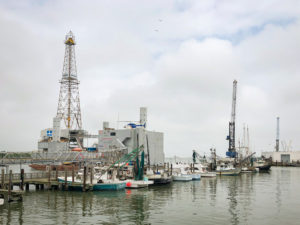 We found an oil rig museum that was quite interesting.
We found an oil rig museum that was quite interesting.
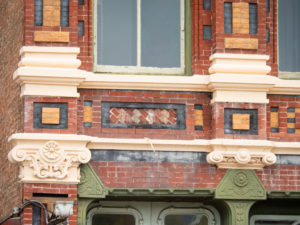 There were a lot of beautiful buildings in Galveston. Some had plaques on them that announced that they had survived the big hurricane of 1900.
There were a lot of beautiful buildings in Galveston. Some had plaques on them that announced that they had survived the big hurricane of 1900.
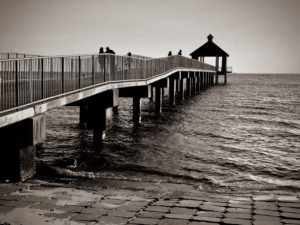
Following south Texas, we headed to Fountainbleau State Park on the north shore of Lake Ponchatrain in Louisiana. It was beautiful and we really wished we had our bikes there. There was an alligator in the pond, Spanish moss hanging from the trees and we were about 40 minutes from NOLA across the causeway.
We spent two days in New Orleans, one just walking around and taking it all in, the other we met my cousin Dave, from Houston, and watched the French Quarter Music Festival parade for the first time in two years (due to Covid). I’ll explore more of that with Music.
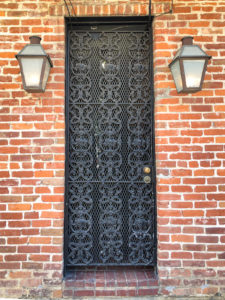
The interesting buildings in NOLA were endless.
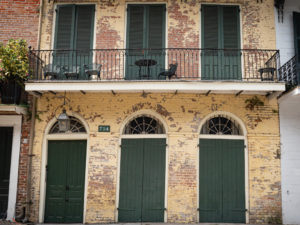
Peeling paint, color, style, NOLA had it all.
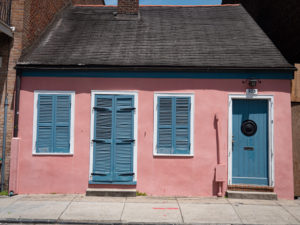
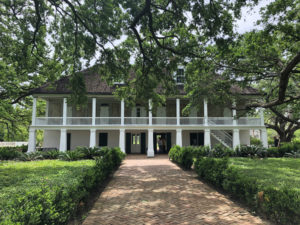 This is a view of the main house of the Whitney Plantation. Such beautiful grounds but such devastating human stories.
This is a view of the main house of the Whitney Plantation. Such beautiful grounds but such devastating human stories.
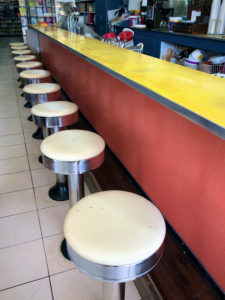
We then found ourselves in Houston, Mississippi, another of Ellen’s old stomping grounds. She lived here for 18 months around her freshman year in high school (1969). This lunch counter at Parson’s Drugstore no doubt saw some sit-ins at some point.
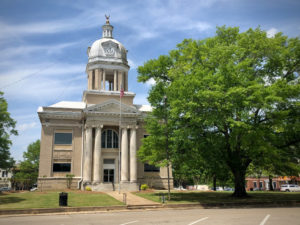
Here is a picture of City Hall and Ellen’s old house.
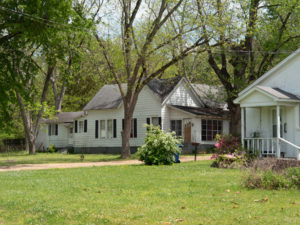
The Hillsborough, Chapel Hill, and Raleigh areas of North Carolina had amazing architecture as well. I learned that Duke and the University of North Carolina, arch college basketball rivals, are across town from each other. Both have BEAUTIFUL campuses.
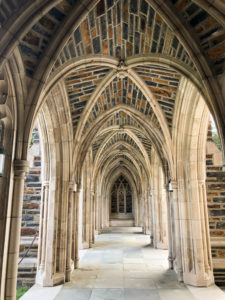
These images are from the Duke University chapel. Below are the catacombs where a few past university presidents are buried.
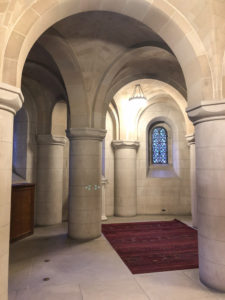
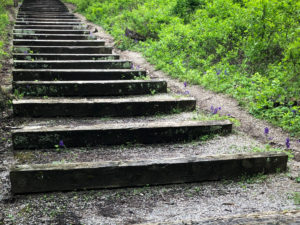 On to Cincinnati! We found this set of steps on a trail in the middle of the city.
On to Cincinnati! We found this set of steps on a trail in the middle of the city.
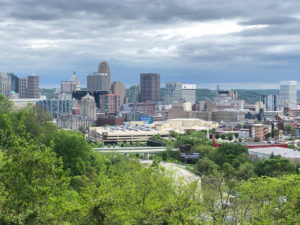
The skyline of Cincinnati and the Purple People Bridge that connects Ohio and Kentucky.
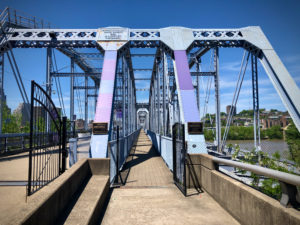
Following Ohio we headed to Nebraska with a stop near Iowa City. We learned of the Amana Colonies so we went there to walk around and have lunch before driving to St. Paul, NE.
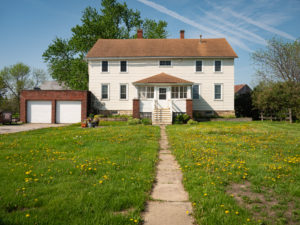
The Amana Colonies are a set of seven villages located near Iowa City. The villages were built and settled by German Radical Pietists, who were persecuted in their homeland. Calling themselves the True Inspiration Congregations, they first settled in New York near Buffalo in what is now the town of West Seneca. However, seeking more isolated surroundings, they moved to Iowa in 1856. They lived a communal life until 1932.
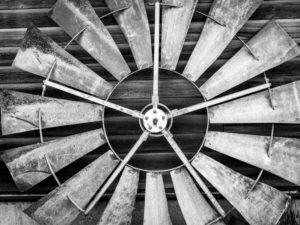
For eighty years, the Amana Colony maintained an almost completely self-sufficient local economy, importing very little from the industrializing American economy. The Amanians were able to achieve this independence and lifestyle by adhering to the specialized crafting and farming occupations that they had brought with them from Europe. Craftsmen passed their skills and techniques on from one generation to the next. They used hand, horse, wind, and water power, and made their own furniture, clothes, and other goods. The community voted to form a for-profit organization during the Great Depression.
Today, the Seven Villages of Amana are a tourist attraction known for their restaurants and craft shops. The colony was listed as a National Historic Landmark in 1965.
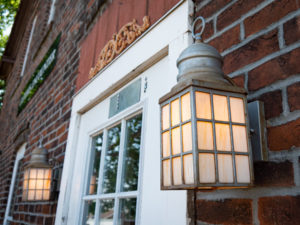
That evening we landed at the farm in St. Paul, NE, following a harrowing thunder/dust storm that prompted tornado warnings as it moved northeast at 65 mph. That is not a typo…65 mph.
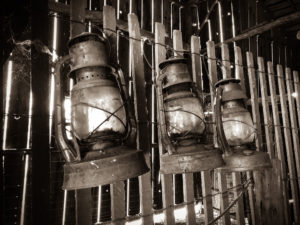
On the farm property is a one hundred-plus-year-old farm, the oldest barn in the county. These milk jugs and lanterns were found in this barn.
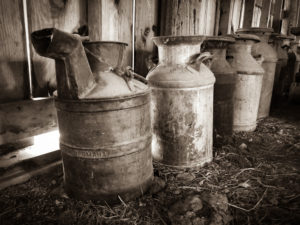
Our final stop was Denver to visit our daughter, Chelsea, my brother Jonathan and his family, and our good friends the Prows.
We parked a street off of the Santa Fe Arts District and found these windows in the church we parked in front of. I loved them.
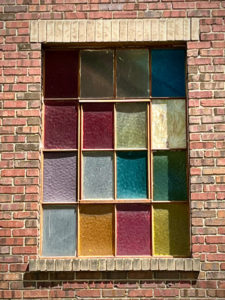
That’s it on the buildings keyword. There was so much more to share but in the tradition of keeping this blog short and to the point this is what I have.
Next week is another of my favorite subjects…transportation!
Happy shooting!
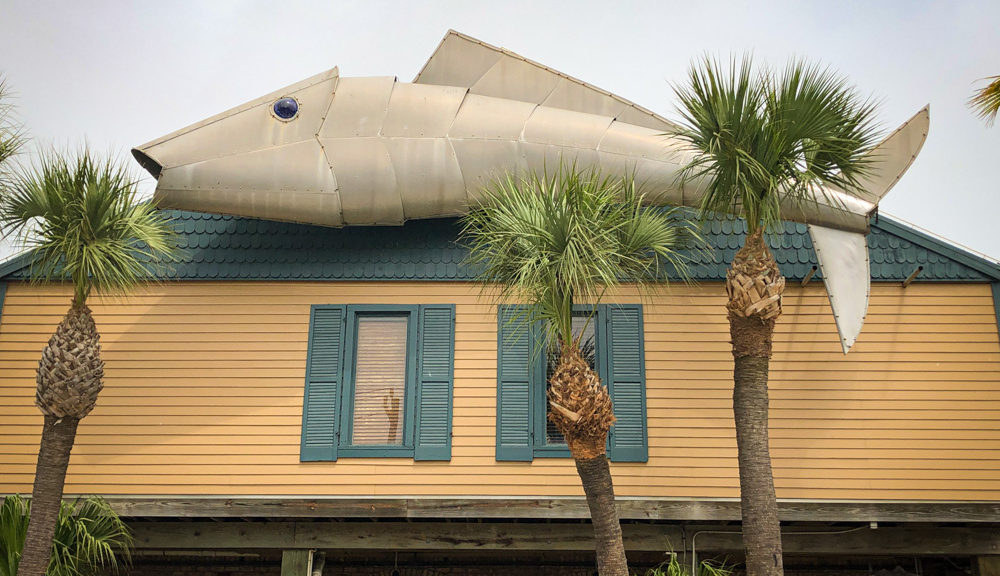
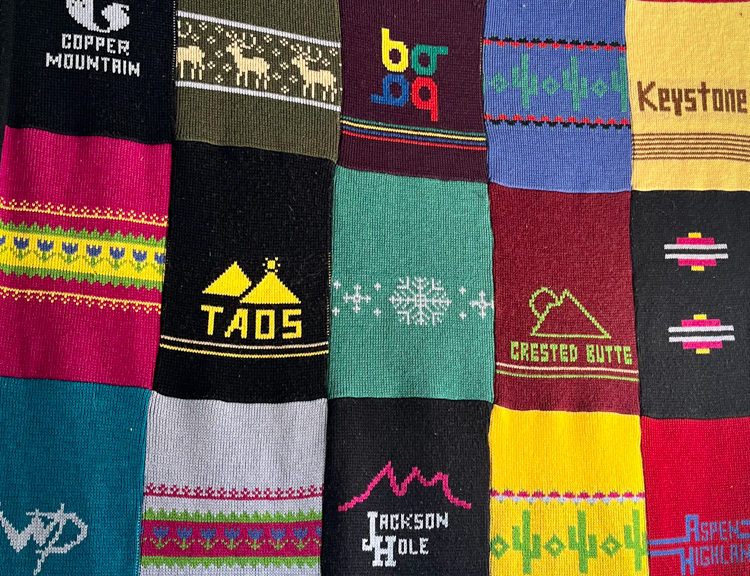
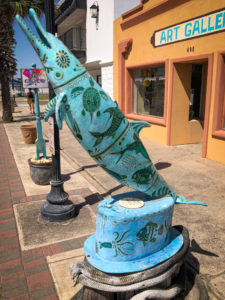 iPhone 8
iPhone 8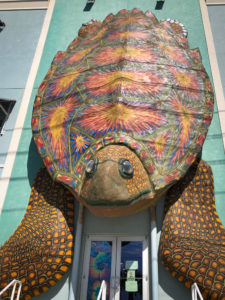 iPhone 8
iPhone 8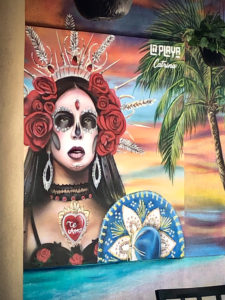 iPhone 8
iPhone 8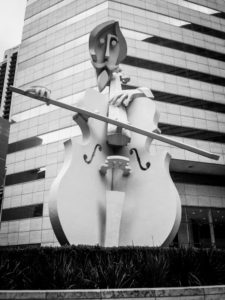 Canon S120 Powershot
Canon S120 Powershot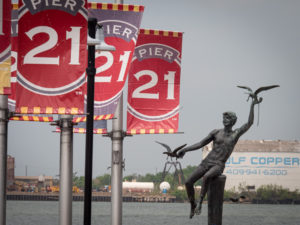 Lumix
Lumix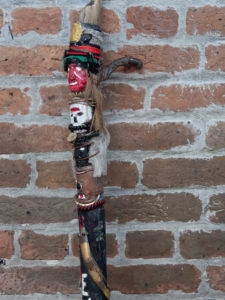 Lumix
Lumix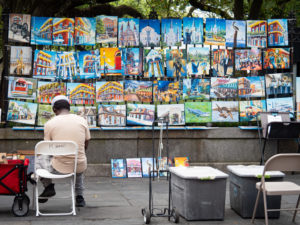 Lumix
Lumix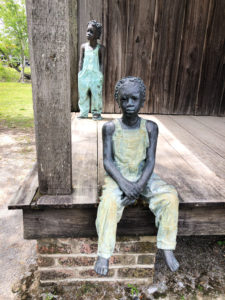 Lumix
Lumix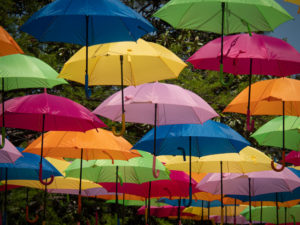 Lumix
Lumix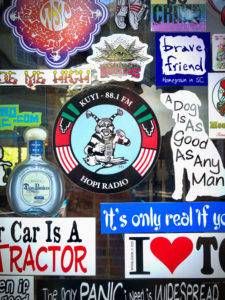 iPhone 8
iPhone 8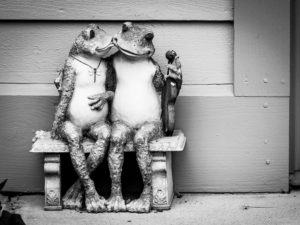 Lumix
Lumix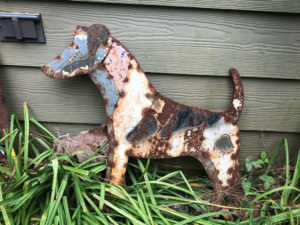 iPhone 8
iPhone 8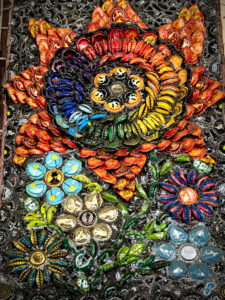 iPhone 8
iPhone 8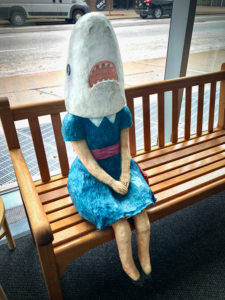 iPhone 8
iPhone 8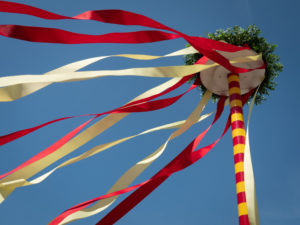 Lumix
Lumix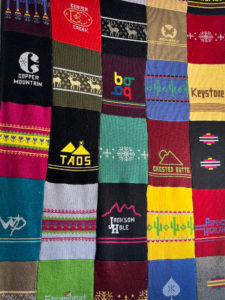 iPhone 8
iPhone 8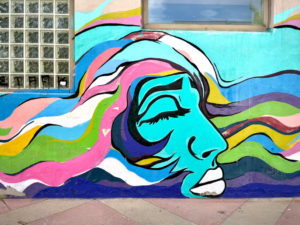 iPhone 8
iPhone 8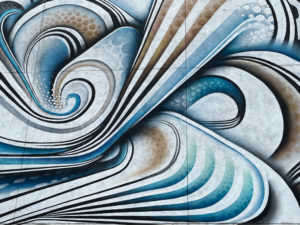 iPhone 8
iPhone 8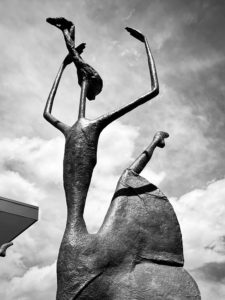 iPhone 8
iPhone 8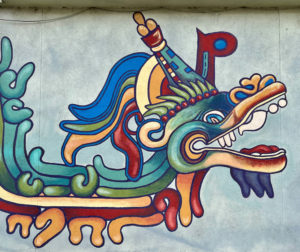 iPhone 8
iPhone 8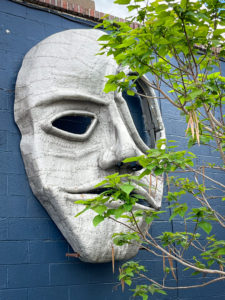 iPhone 8
iPhone 8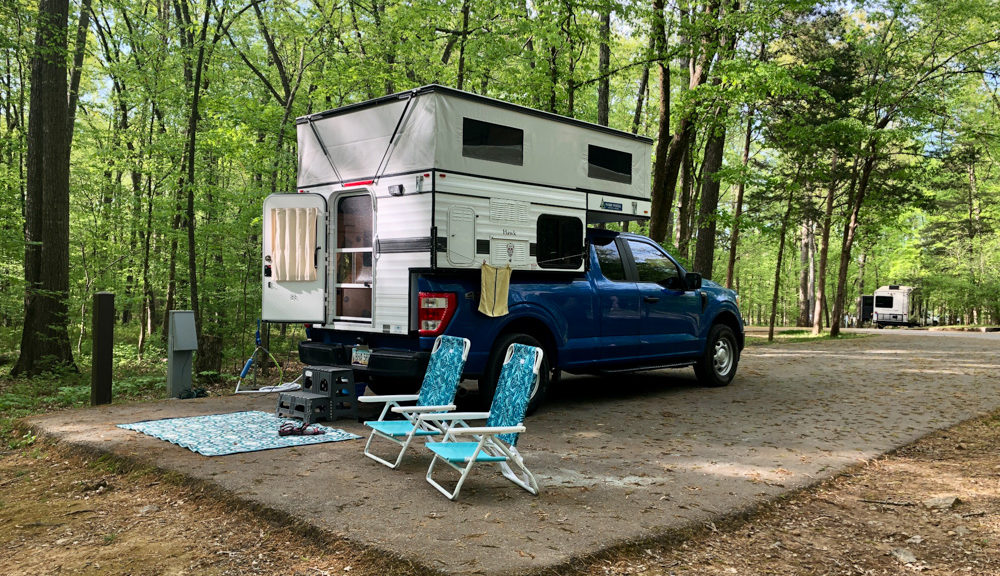
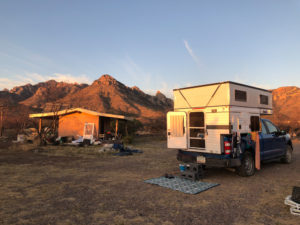 Our first three nights were spent in Portal, AZ. It’s a little community located in southeastern Arizona not far from the Mexican border. Our good friends have a lovely piece of land there just east of Chiricahua National Monument. It was a great place to land on our first big driving day in Coyote Hawk. Heading out from Flagstaff was mostly downhill so we got crazy good gas mileage; 22 mpg to be exact.
Our first three nights were spent in Portal, AZ. It’s a little community located in southeastern Arizona not far from the Mexican border. Our good friends have a lovely piece of land there just east of Chiricahua National Monument. It was a great place to land on our first big driving day in Coyote Hawk. Heading out from Flagstaff was mostly downhill so we got crazy good gas mileage; 22 mpg to be exact.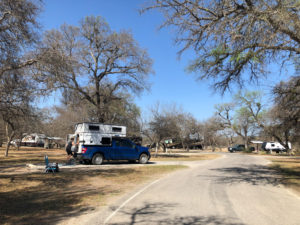 We LOVED this park. We wished we had brought our bicycles, as there was some riding to be had. This is also where we got to interact with armadillos for the first time. That will be in a later post.
We LOVED this park. We wished we had brought our bicycles, as there was some riding to be had. This is also where we got to interact with armadillos for the first time. That will be in a later post.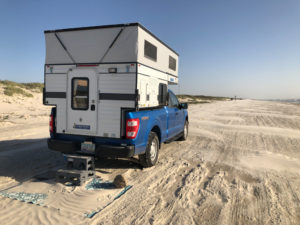 It turns out that in Texas one can just drive on any beach and camp. Pretty cool. As you can see we were quite a distance from any other camp. But as you can also see, the winds had picked up the afternoon before, blew hard all night, and blew sand all over our mat. It blew so hard that we moved our truck, in the middle of the night, to face the wind and try to reduce some of the rocking from the gusts. Needless to say, with fine sand blowing everywhere and no relief in sight, we called it after one night and headed to Harlingen.
It turns out that in Texas one can just drive on any beach and camp. Pretty cool. As you can see we were quite a distance from any other camp. But as you can also see, the winds had picked up the afternoon before, blew hard all night, and blew sand all over our mat. It blew so hard that we moved our truck, in the middle of the night, to face the wind and try to reduce some of the rocking from the gusts. Needless to say, with fine sand blowing everywhere and no relief in sight, we called it after one night and headed to Harlingen.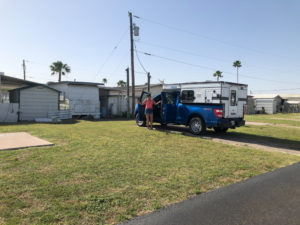
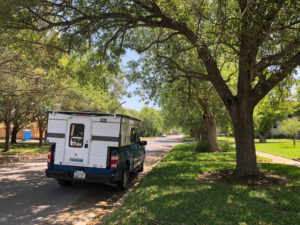
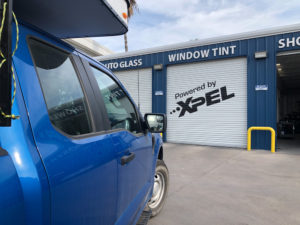 One of the upgrades we decided our rig needed was to tint the truck’s windows. Wow, what a difference it made with the sun and heat.
One of the upgrades we decided our rig needed was to tint the truck’s windows. Wow, what a difference it made with the sun and heat.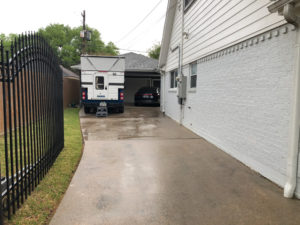 From Harlingen, we headed to Houston to stay with cousin Dave and his husband Bong. We easily could have camped in the driveway but were invited into an upstairs room and private bath. It was here that I think we began to realize that staying in the camper is easier and just as, if not more, comfortable for us.
From Harlingen, we headed to Houston to stay with cousin Dave and his husband Bong. We easily could have camped in the driveway but were invited into an upstairs room and private bath. It was here that I think we began to realize that staying in the camper is easier and just as, if not more, comfortable for us.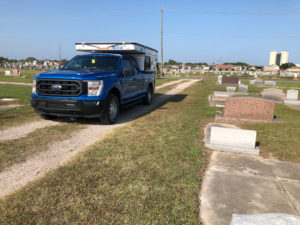
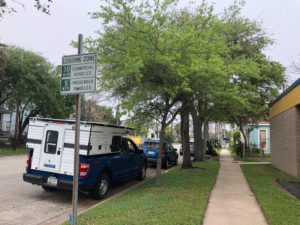
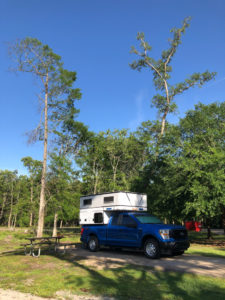
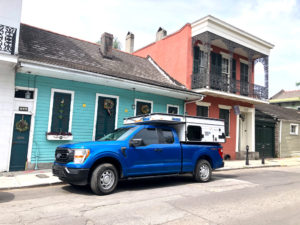
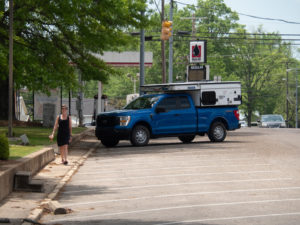
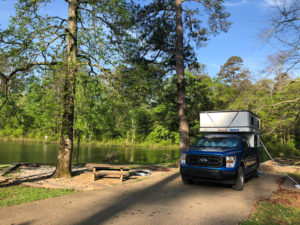
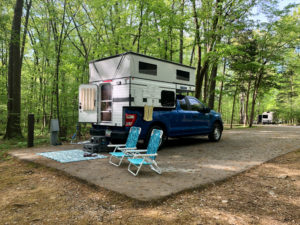 The next stop was Henry Horton State Park just south of Nashville, TN. This was another park we loved and wished we had bikes to explore with. We didn’t bring the bikes as we didn’t want them hanging off the back, ripe for theft, as we visited the cities on our trip. Stay tuned and you’ll see what we came up with.
The next stop was Henry Horton State Park just south of Nashville, TN. This was another park we loved and wished we had bikes to explore with. We didn’t bring the bikes as we didn’t want them hanging off the back, ripe for theft, as we visited the cities on our trip. Stay tuned and you’ll see what we came up with.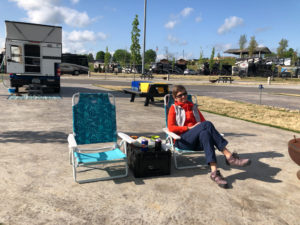 THIS two-night, one-day experience was all about Dollywood! We stayed at The Ridge Resort in Sevierville, Dolly Pardon’s hometown. The RV park had a LOT of concrete, very manicured lawns, twice-daily trash pick-up (I’m serious), and giant bus-sized RVs surrounding us. We felt like we used to after canoe camping at Lake Powell and paddling over to the restaurant for a meal and mixing with all the clean houseboaters. We were a bit out of our league.
THIS two-night, one-day experience was all about Dollywood! We stayed at The Ridge Resort in Sevierville, Dolly Pardon’s hometown. The RV park had a LOT of concrete, very manicured lawns, twice-daily trash pick-up (I’m serious), and giant bus-sized RVs surrounding us. We felt like we used to after canoe camping at Lake Powell and paddling over to the restaurant for a meal and mixing with all the clean houseboaters. We were a bit out of our league.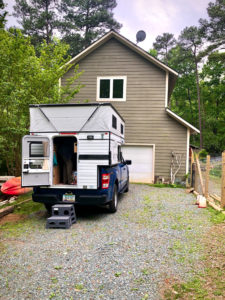
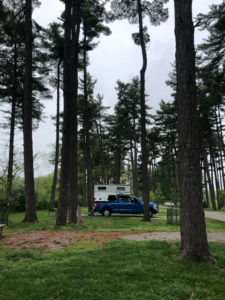
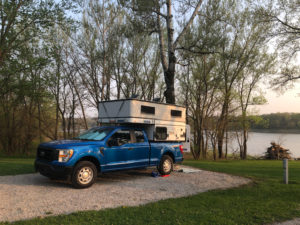
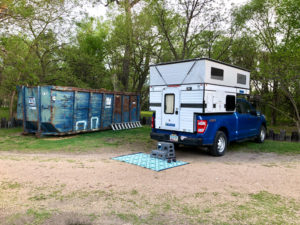
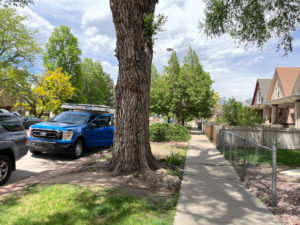
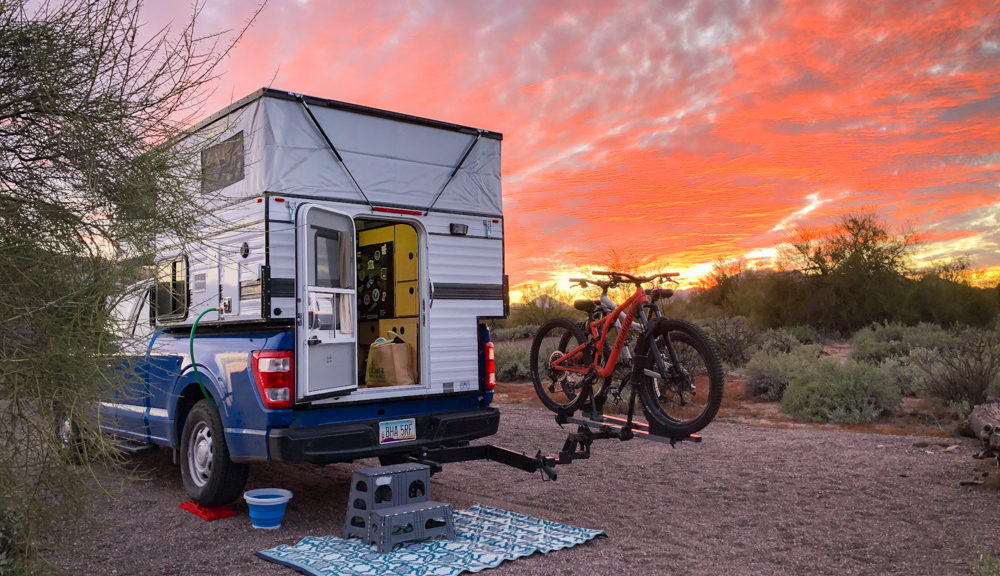
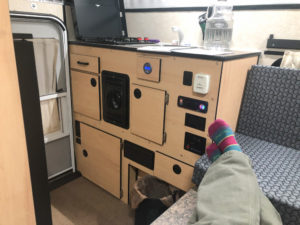
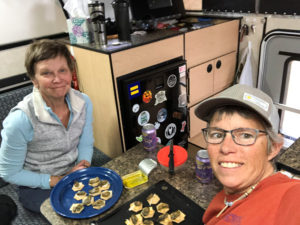
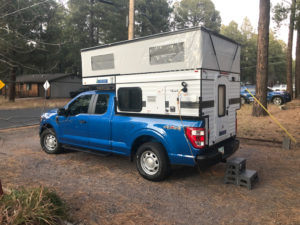
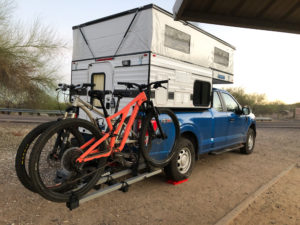
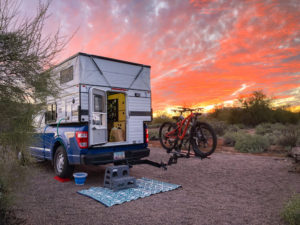
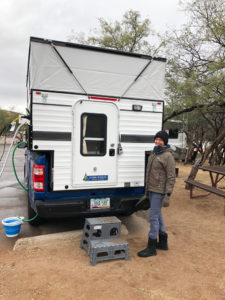 The other item we recently fixed, with the help of our brilliant friend Rod Horn, was the after-market backup camera. Ours disappeared when we took off the tailgate. Rod machined a bracket that goes over the license plate and he was able to attach the backup camera to it. Works like a charm.
The other item we recently fixed, with the help of our brilliant friend Rod Horn, was the after-market backup camera. Ours disappeared when we took off the tailgate. Rod machined a bracket that goes over the license plate and he was able to attach the backup camera to it. Works like a charm.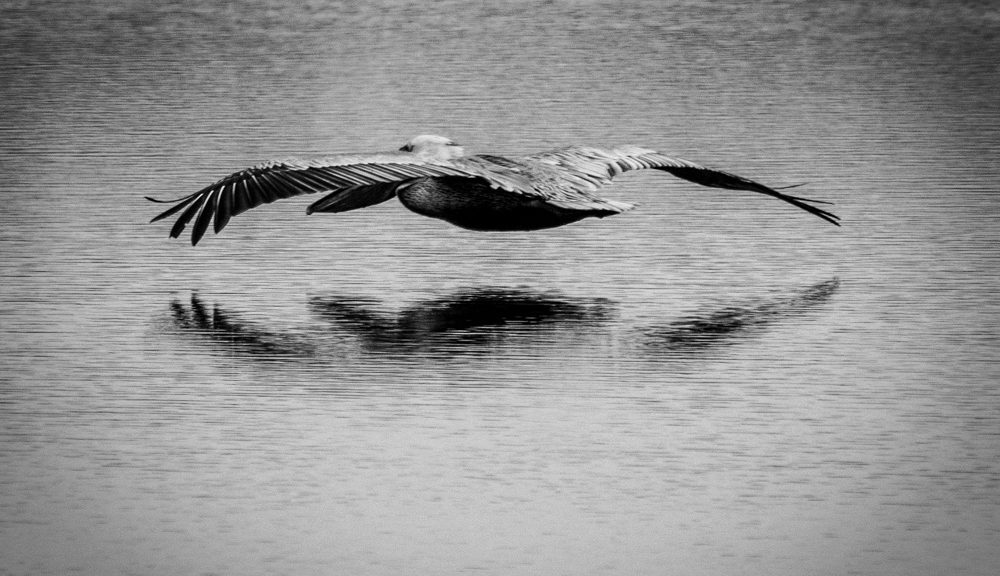
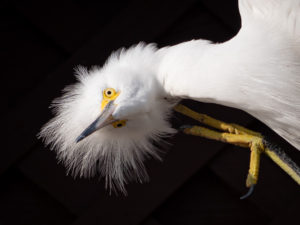
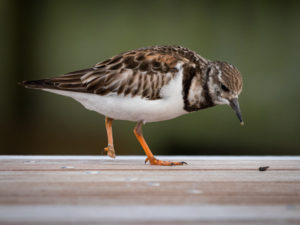 This Ruddy Turnstone was wandering the pier. I hadn’t noticed he had lost a foot until I downloaded the image.
This Ruddy Turnstone was wandering the pier. I hadn’t noticed he had lost a foot until I downloaded the image.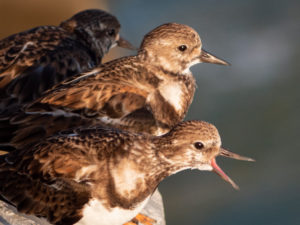 More Ruddy Turnstones squawking out below the railings along the pier.
More Ruddy Turnstones squawking out below the railings along the pier.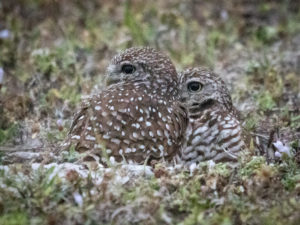
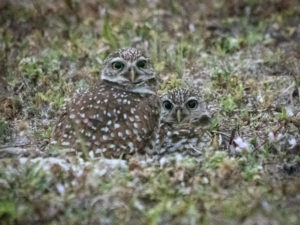
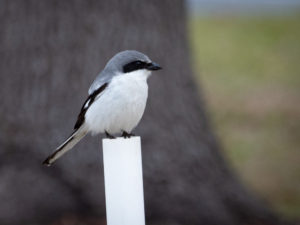 I found this Loggerhead Shrike hanging out on a post.
I found this Loggerhead Shrike hanging out on a post.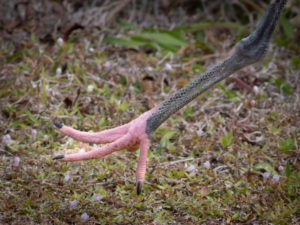 This Wood Stork was showing off her new pedicure.
This Wood Stork was showing off her new pedicure.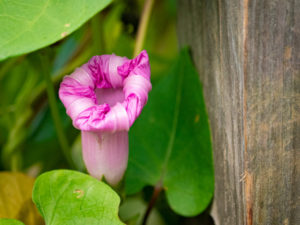 If you can look past the birds there are some pretty cool plants in Florida as well.
If you can look past the birds there are some pretty cool plants in Florida as well.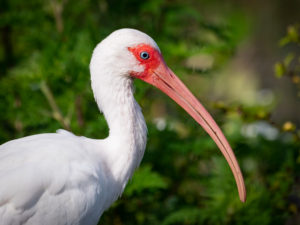 The White Ibis. As common in Florida as pigeons.
The White Ibis. As common in Florida as pigeons.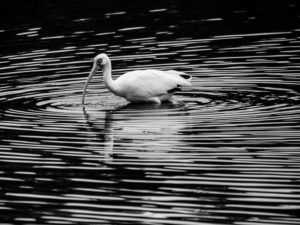 Florida Pigeion (White Ibis)
Florida Pigeion (White Ibis)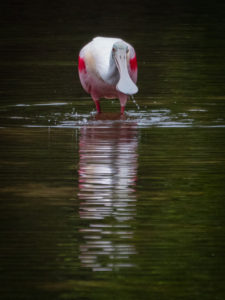 Roseate Spoonbill, a crowd favorite.
Roseate Spoonbill, a crowd favorite.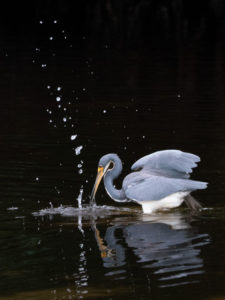 A fishing Tri-Colored Heron.
A fishing Tri-Colored Heron.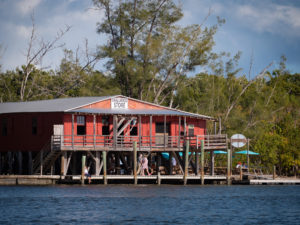 This was our lunch spot. See the green umbrellas behind the building? We ate at those tables. At this point, I believe we were either in or at least at the edge of Everglades National Park.
This was our lunch spot. See the green umbrellas behind the building? We ate at those tables. At this point, I believe we were either in or at least at the edge of Everglades National Park.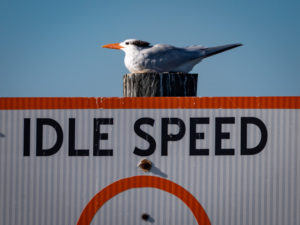
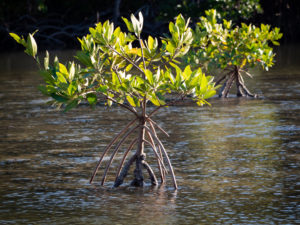 A couple of baby mangroves taking root.
A couple of baby mangroves taking root.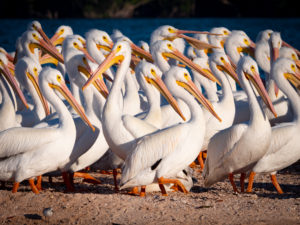 Our captain showed us an Osprey nest, a Bald Eagle nest, a shell island built by Native People over hundreds of years, and a spit of land that housed these White Pelicans. They were chillin’ on the beach until we floated a little too close. They then got into formation, except for the one guy, and tried to march but had nowhere to go. We motored back away from them and everyone mellowed out.
Our captain showed us an Osprey nest, a Bald Eagle nest, a shell island built by Native People over hundreds of years, and a spit of land that housed these White Pelicans. They were chillin’ on the beach until we floated a little too close. They then got into formation, except for the one guy, and tried to march but had nowhere to go. We motored back away from them and everyone mellowed out.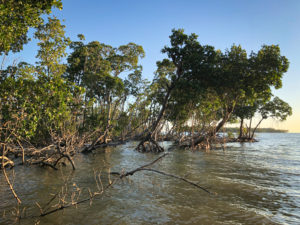 We toured an area full of islands like this. We had a regular prop boat, not an airboat like they use in the thick of the Everglades. All three boats met up at sundown at one particular island where many birds go to roost for the evening. It was quite a sight.
We toured an area full of islands like this. We had a regular prop boat, not an airboat like they use in the thick of the Everglades. All three boats met up at sundown at one particular island where many birds go to roost for the evening. It was quite a sight.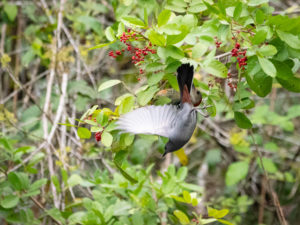
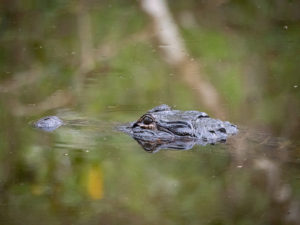 AND! An alligator.
AND! An alligator.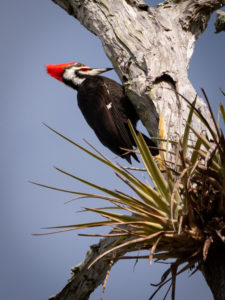 Woody Woodpecker made an appearance on our way back to the vehicles. We heard him for most of the trek in so when he finally made himself seen everyone was quite excited.
Woody Woodpecker made an appearance on our way back to the vehicles. We heard him for most of the trek in so when he finally made himself seen everyone was quite excited.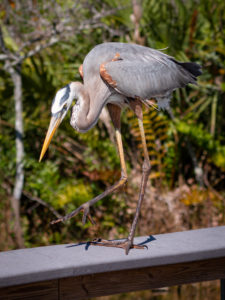
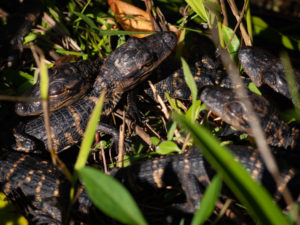 These little guys attracted a crowd. They were literally at our feet in the weeds. Just across the way was mama. She never seemed too concerned, luckily.
These little guys attracted a crowd. They were literally at our feet in the weeds. Just across the way was mama. She never seemed too concerned, luckily.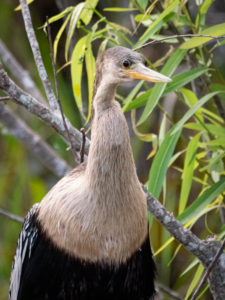 A goofy-looking Anhinga.
A goofy-looking Anhinga.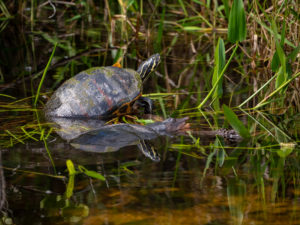 Two different types of turtles, one on the stick and one just below it in the water.
Two different types of turtles, one on the stick and one just below it in the water.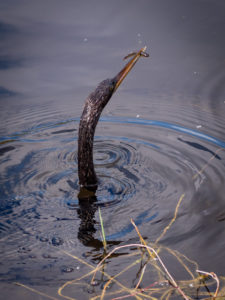 This Anhinga was swimming underwater like a snake. He’d come up for air and usually had a little fish in its bill. It was such a great place to shoot because you could follow his path on the footpath. The canal was narrow enough that the animals were never too far away.
This Anhinga was swimming underwater like a snake. He’d come up for air and usually had a little fish in its bill. It was such a great place to shoot because you could follow his path on the footpath. The canal was narrow enough that the animals were never too far away.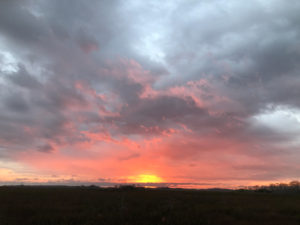 Sunrise was beautiful.
Sunrise was beautiful.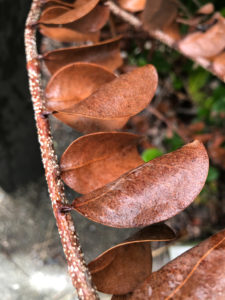
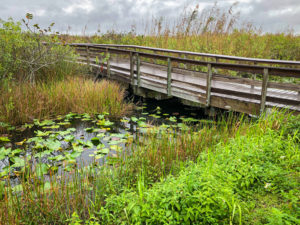 The boardwalks were super cool. Even if I wasn’t super inspired to shoot I was really glad just to be there and enjoy the magic that is the Everglades.
The boardwalks were super cool. Even if I wasn’t super inspired to shoot I was really glad just to be there and enjoy the magic that is the Everglades.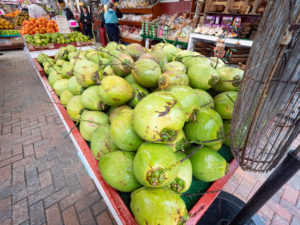
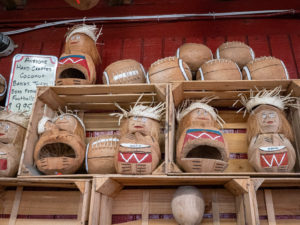 Read the sign to the left of the coconut carvings to see what they actually are.
Read the sign to the left of the coconut carvings to see what they actually are.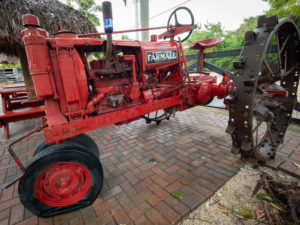 They also had quite the collection of old tractors.
They also had quite the collection of old tractors.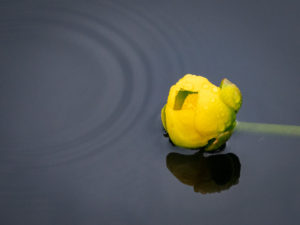
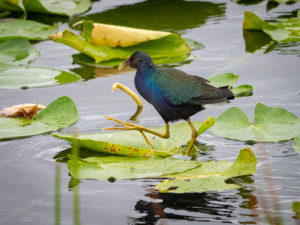 This Purple Gallinule has some BIG feet! He uses them to run across the tops of the lilypads. In sunlight, he is VERY iridescent. But seriously, those FEET!
This Purple Gallinule has some BIG feet! He uses them to run across the tops of the lilypads. In sunlight, he is VERY iridescent. But seriously, those FEET!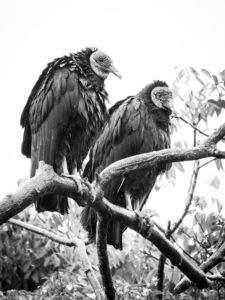 Hanging out in the rain.
Hanging out in the rain.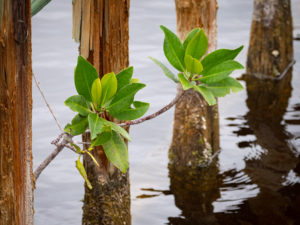
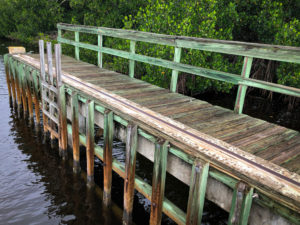
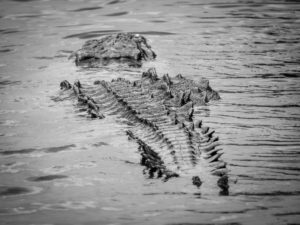
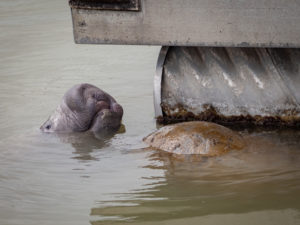 The manatees were drinking drips coming off the floating dock.
The manatees were drinking drips coming off the floating dock.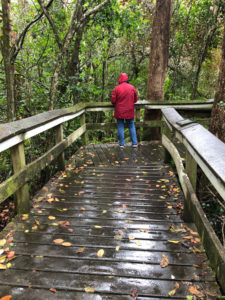
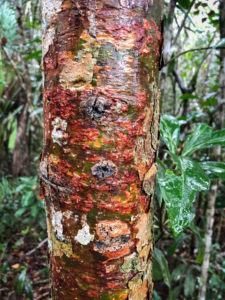
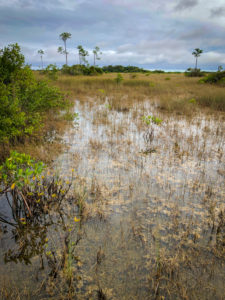
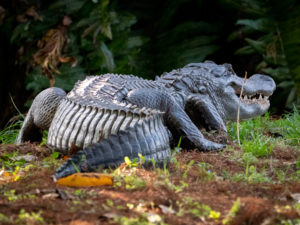
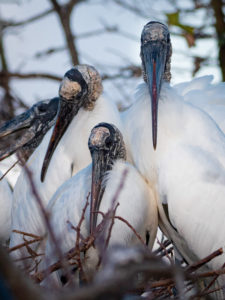
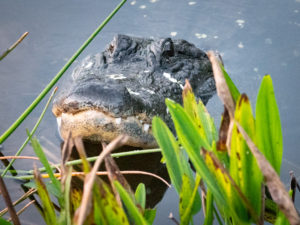
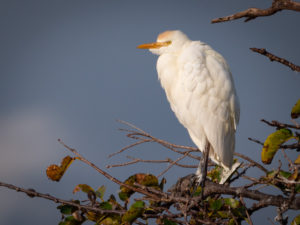
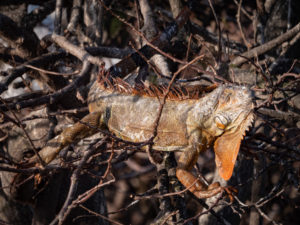 Apparently the week before, these guys were falling out of trees it was so cold.
Apparently the week before, these guys were falling out of trees it was so cold.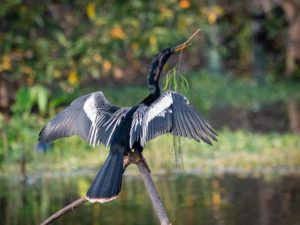 There was a LOT of nesting and courtship activity.
There was a LOT of nesting and courtship activity.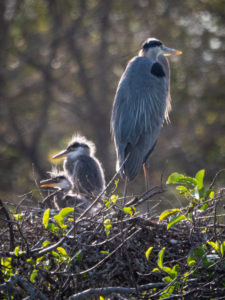 Baby Great Blue Herons!! They are definitely ugly cute. They were the only babies I saw. The rest were in preparation.
Baby Great Blue Herons!! They are definitely ugly cute. They were the only babies I saw. The rest were in preparation.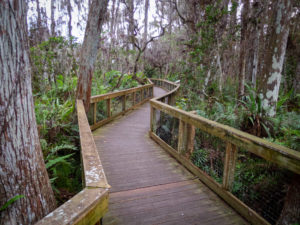
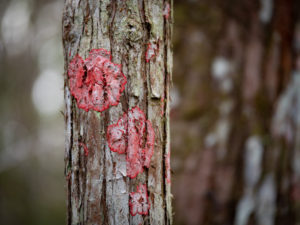
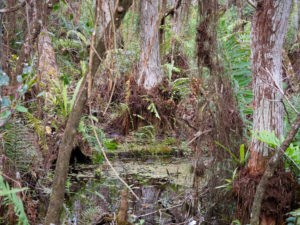
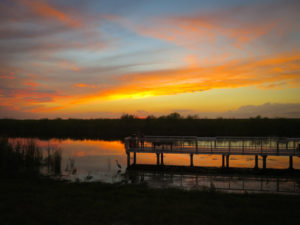
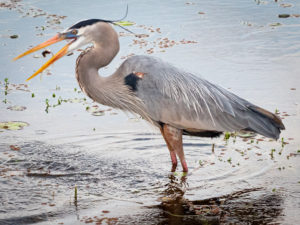
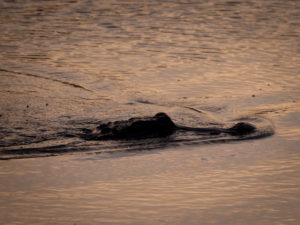
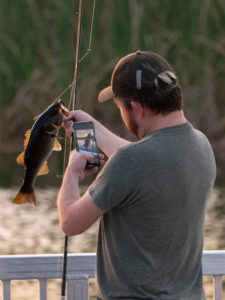
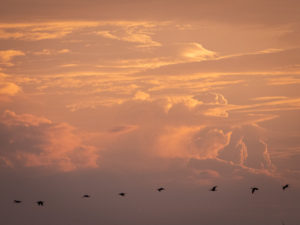
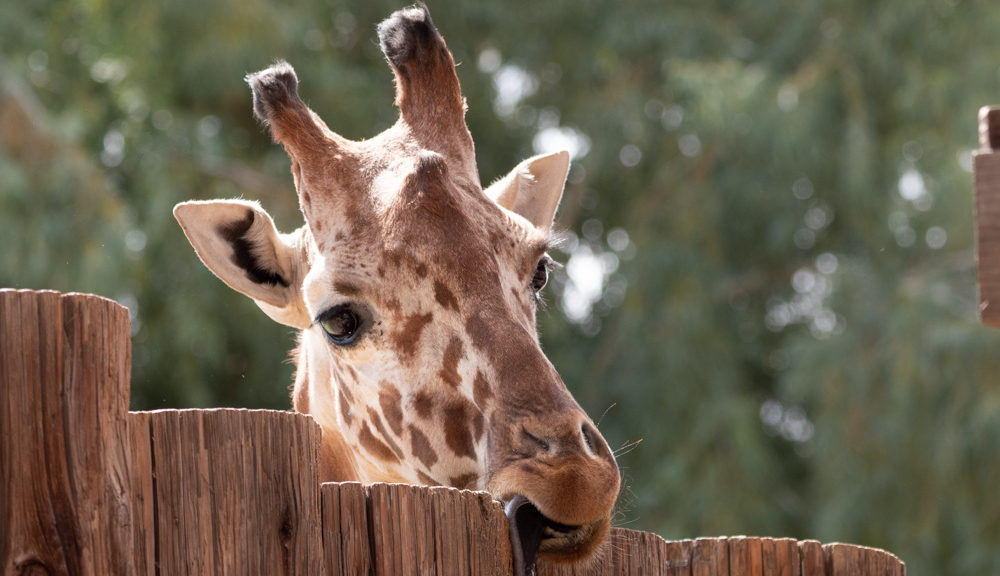
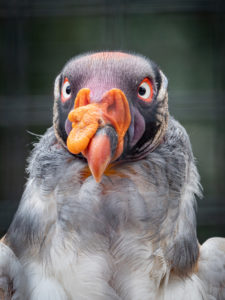 The fence in this image is so blurred it almost appears as part of the background.
The fence in this image is so blurred it almost appears as part of the background.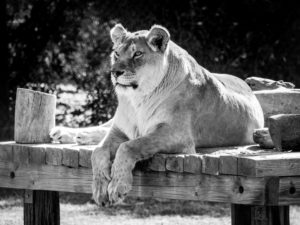 This lioness was watching the day go by behind a chainlink fence.
This lioness was watching the day go by behind a chainlink fence.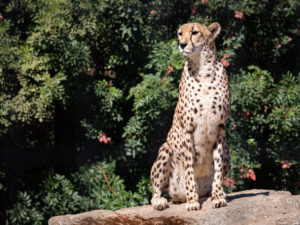 All the animals were quite active on that day. We’re assuming due to a cool front moving through the state.
All the animals were quite active on that day. We’re assuming due to a cool front moving through the state.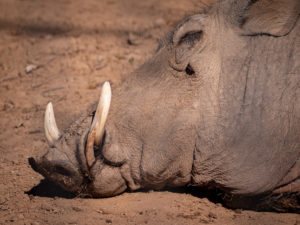 “Pumba, you ARE a pig”. The warthogs were also behind a fence. Again, the fence is so blurred it’s barely noticeable.
“Pumba, you ARE a pig”. The warthogs were also behind a fence. Again, the fence is so blurred it’s barely noticeable.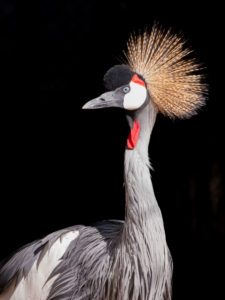 This crane image was captured on the safari tram through Africa. I was able to use Lightroom to grab the background, take down the exposure to make it appear as shade, and highlight her (his?) beauty.
This crane image was captured on the safari tram through Africa. I was able to use Lightroom to grab the background, take down the exposure to make it appear as shade, and highlight her (his?) beauty.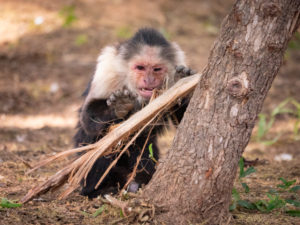 This little guy was on a monkey island across some water. He was going to town on a piece of tree. His little old man expressions were super cute.
This little guy was on a monkey island across some water. He was going to town on a piece of tree. His little old man expressions were super cute.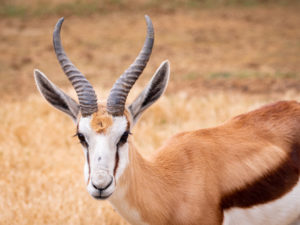 Again from the Safari Tram ride, we saw this gazelle.
Again from the Safari Tram ride, we saw this gazelle.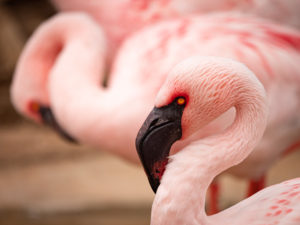 Zombie Flamingo Appocolypse?
Zombie Flamingo Appocolypse?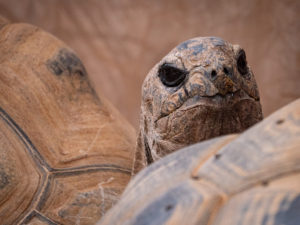
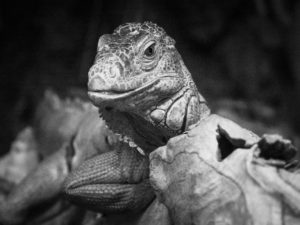
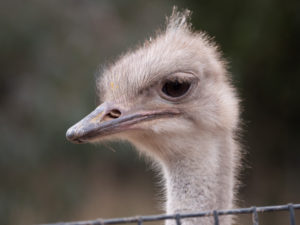 You can see the fence that this ostrich was behind. He (she?) was pretty close. Apparently, the ostrich is not the sharpest tool in the shed. They do, however, provide for some great facial expressions.
You can see the fence that this ostrich was behind. He (she?) was pretty close. Apparently, the ostrich is not the sharpest tool in the shed. They do, however, provide for some great facial expressions.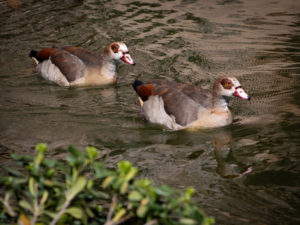 Egyptian Geese.
Egyptian Geese.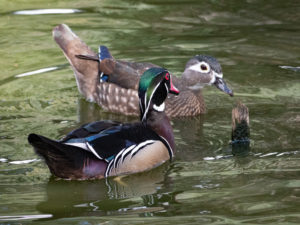 A pair of wood ducks with her in full mating regalia. I caught them just before they, well, YOU know, they tried making baby ducks. I hope they were successful.
A pair of wood ducks with her in full mating regalia. I caught them just before they, well, YOU know, they tried making baby ducks. I hope they were successful.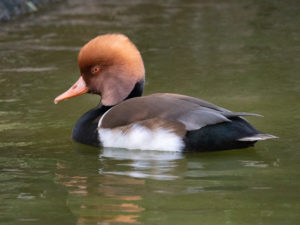 A beautiful Red-Crested Pochard looking for a mate.
A beautiful Red-Crested Pochard looking for a mate.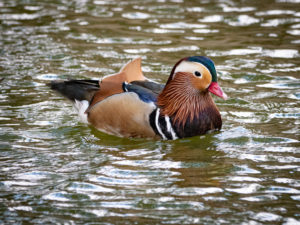 A very colorful Mandarin Duck strutting his stuff.
A very colorful Mandarin Duck strutting his stuff.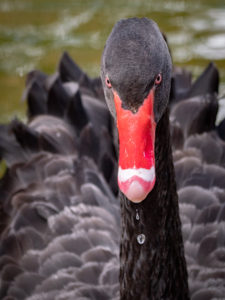 There were even a couple of majestic black swans.
There were even a couple of majestic black swans.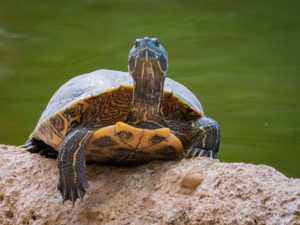 …and a turtle.
…and a turtle.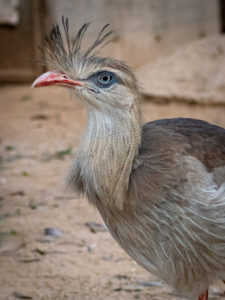
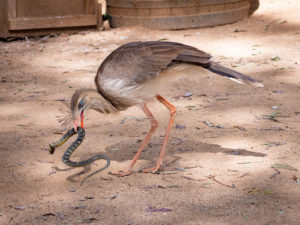
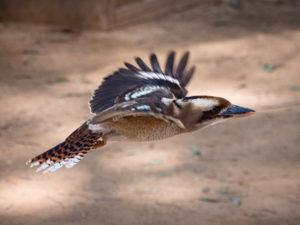
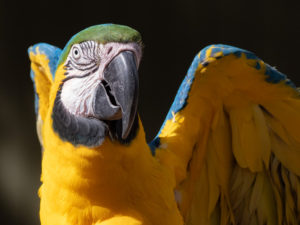 Macaws close up are always nifty.
Macaws close up are always nifty.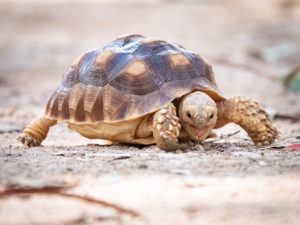
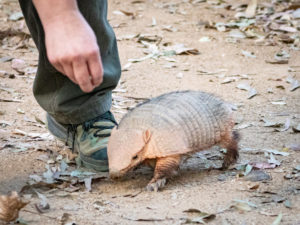
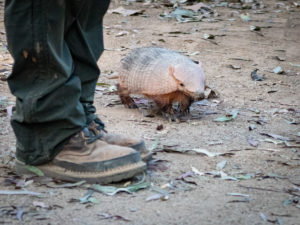
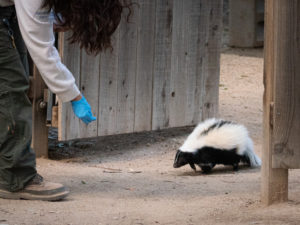 This one always makes me nervous. But he (she?) performed wonderfully. He came out in front of the stage and was quite well behaved, keeping all parts of himself…TO himself.
This one always makes me nervous. But he (she?) performed wonderfully. He came out in front of the stage and was quite well behaved, keeping all parts of himself…TO himself.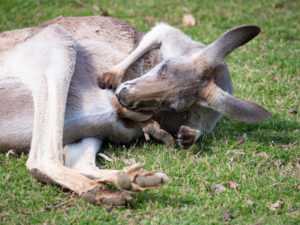
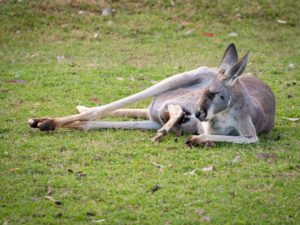
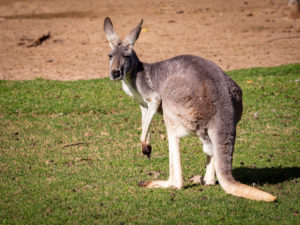
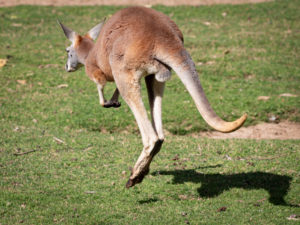
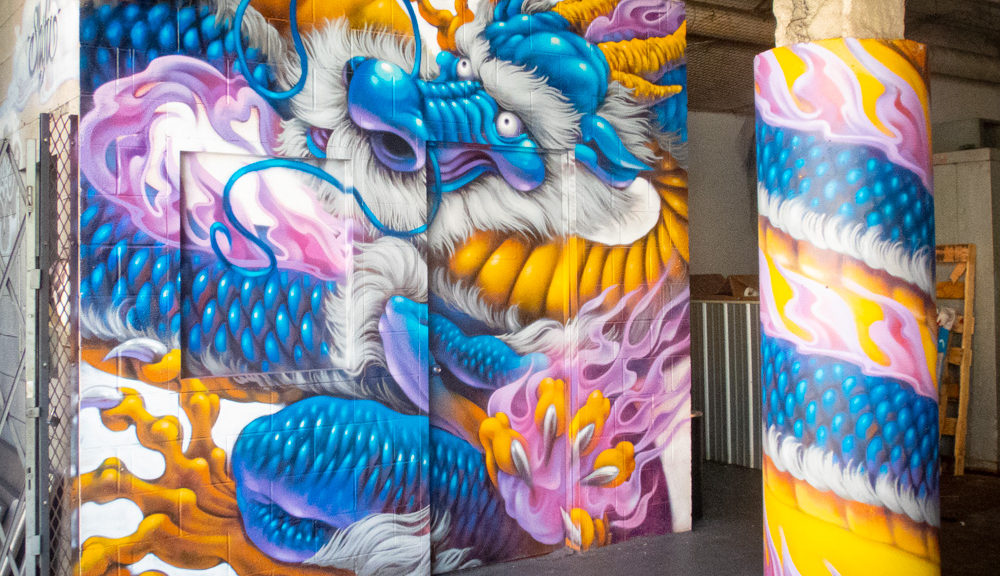
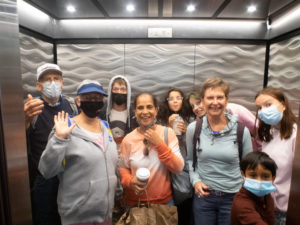 This is the crew we went with: my mom, step-dad, sister-in-law, and her two kids, granddaughter, nephew, and my cousin’s kid. It was a formidable team.
This is the crew we went with: my mom, step-dad, sister-in-law, and her two kids, granddaughter, nephew, and my cousin’s kid. It was a formidable team.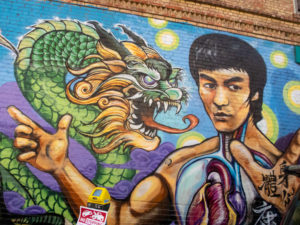
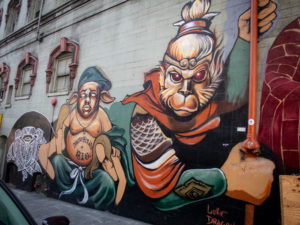
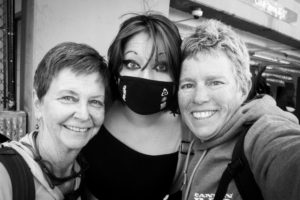 My wife, Ellen, and I with our granddaughter. It was her first trip to see the family in eight years.
My wife, Ellen, and I with our granddaughter. It was her first trip to see the family in eight years.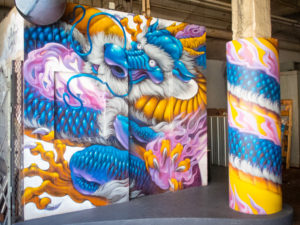 I love wondering unfamiliar cities and finding treasures like this parking garage entrance.
I love wondering unfamiliar cities and finding treasures like this parking garage entrance.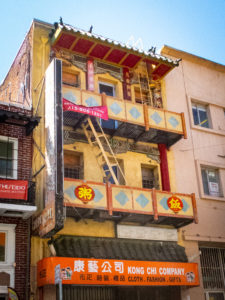
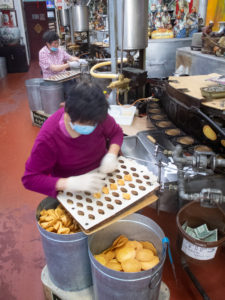 We HAD to stop by the fortune cookie factory!
We HAD to stop by the fortune cookie factory!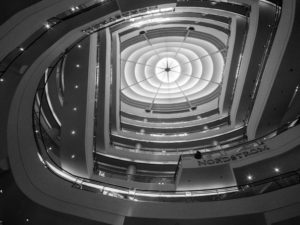
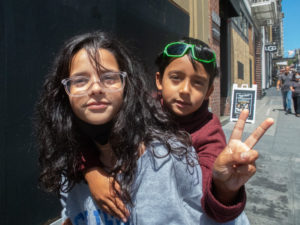 Our two youngest team members were SUCH troopers.
Our two youngest team members were SUCH troopers.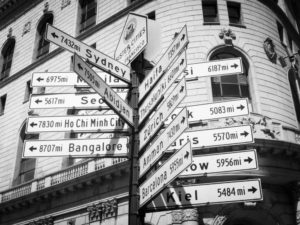 After lunch, we boarded the trolly and headed to Fisherman’s Wharf where we ended the day. From there we walked back to the Ferry Building and headed home.
After lunch, we boarded the trolly and headed to Fisherman’s Wharf where we ended the day. From there we walked back to the Ferry Building and headed home. 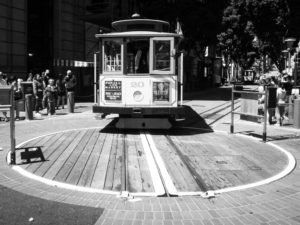
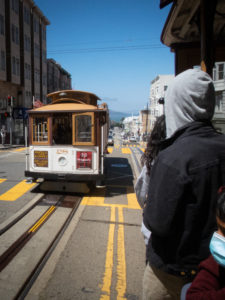
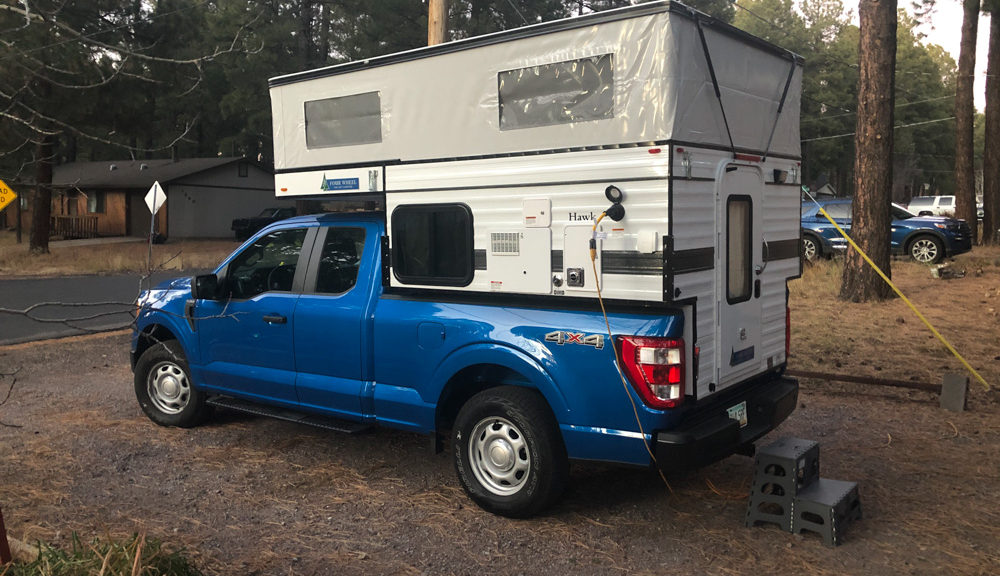
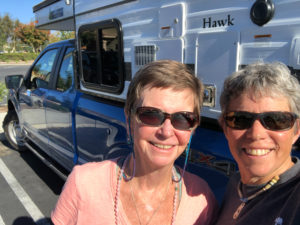
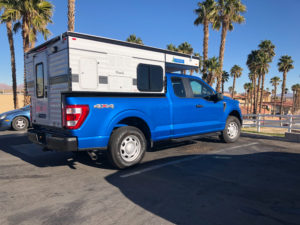


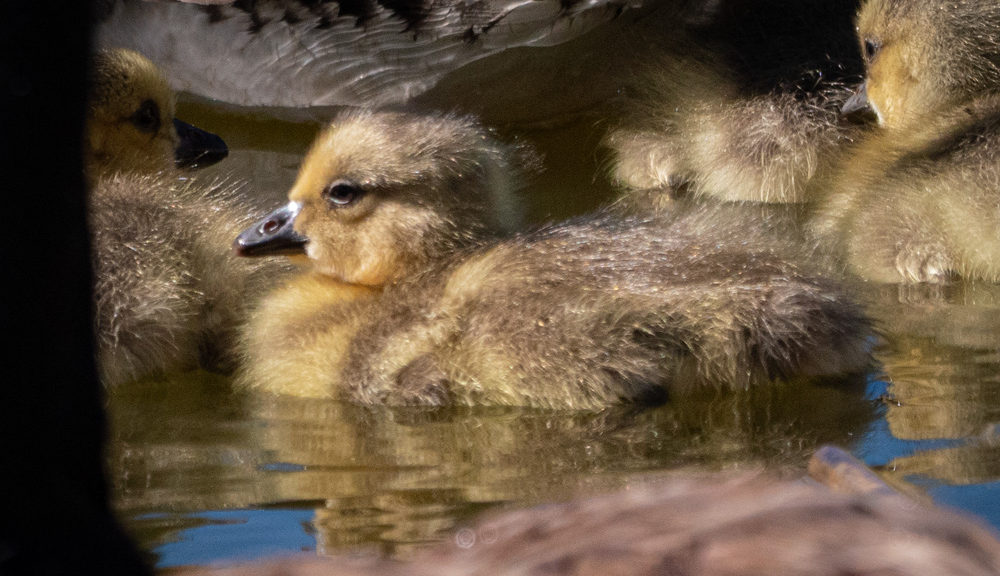
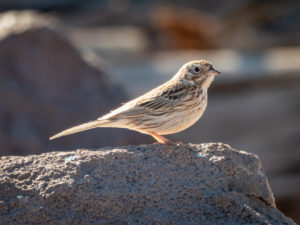 I wasn’t sure what this little guy was so I posted it on FaceBook and asked the birding community to identify. They were quick! It’s a vesper sparrow.
I wasn’t sure what this little guy was so I posted it on FaceBook and asked the birding community to identify. They were quick! It’s a vesper sparrow.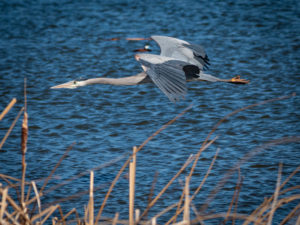 Catching them in flight is challenging. I set the camera at 400-800 ISO, in full sunlight which gives me a shutter speed between 2,000 and 6,000.
Catching them in flight is challenging. I set the camera at 400-800 ISO, in full sunlight which gives me a shutter speed between 2,000 and 6,000.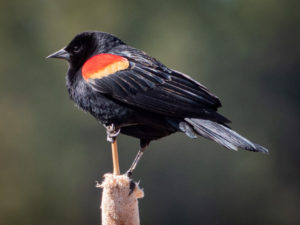 Perched birds are easier but you still have to be quick. They don’t always hang out for a photo! This is a red-winged blackbird.
Perched birds are easier but you still have to be quick. They don’t always hang out for a photo! This is a red-winged blackbird.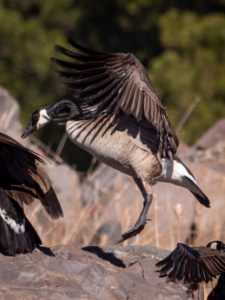 Coming in for a landing!!
Coming in for a landing!!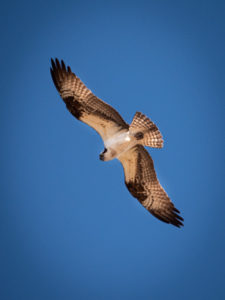 I’ve seen as many as four ospreys hunting the ponds of these wetlands.
I’ve seen as many as four ospreys hunting the ponds of these wetlands.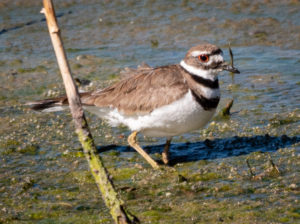 This looks like a shorebird to me. It’s a killdeer. On another day I caught one with a worm in its mouth!
This looks like a shorebird to me. It’s a killdeer. On another day I caught one with a worm in its mouth!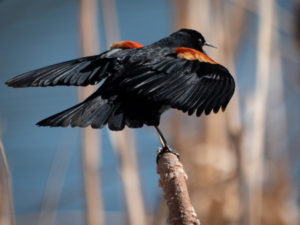 They are so dramatic when they sing!
They are so dramatic when they sing!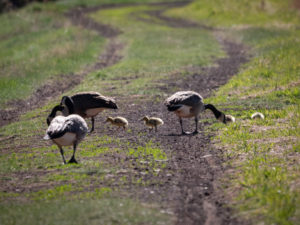 The first goslings of the season!
The first goslings of the season!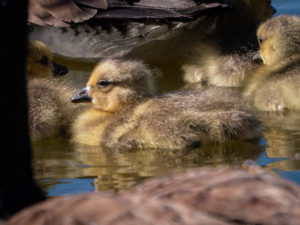
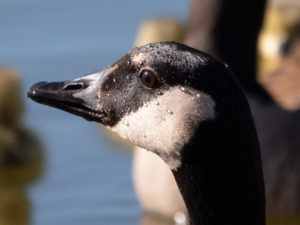
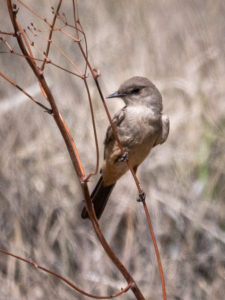 This one was tough to capture. It didn’t hang out for long so I had to be quick. Luckily, with the length of the lens, I don’t have to get too close and the birds tend to not skitter away quite as quickly as when I tried to capture images of them with my 28-300 mm lens.
This one was tough to capture. It didn’t hang out for long so I had to be quick. Luckily, with the length of the lens, I don’t have to get too close and the birds tend to not skitter away quite as quickly as when I tried to capture images of them with my 28-300 mm lens.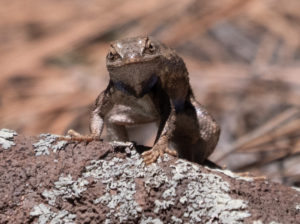 Turns out it’s also a reptile lens!
Turns out it’s also a reptile lens!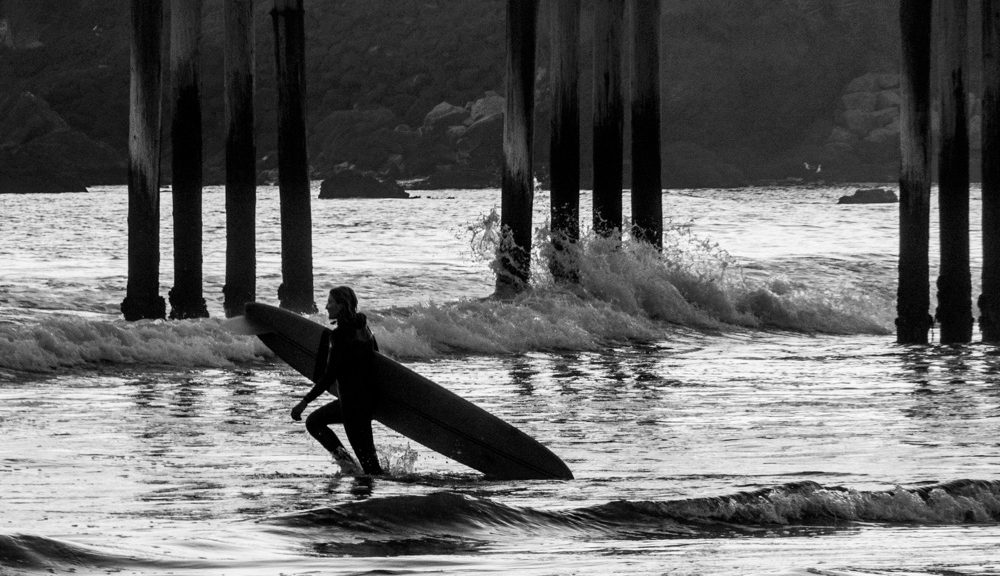
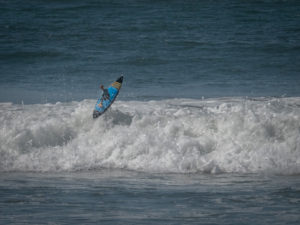
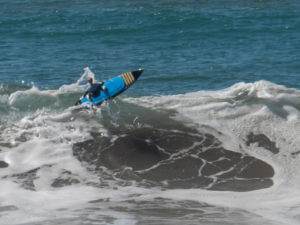
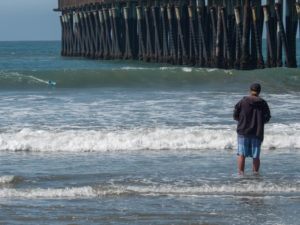
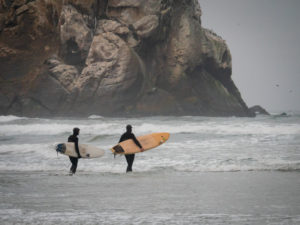 Now, on to the dedication part. The temps were in the high 40’s each morning. These guys were decked in full, hooded wetsuits WITH booties. No thank you. Too cold for this lover of oceans.
Now, on to the dedication part. The temps were in the high 40’s each morning. These guys were decked in full, hooded wetsuits WITH booties. No thank you. Too cold for this lover of oceans.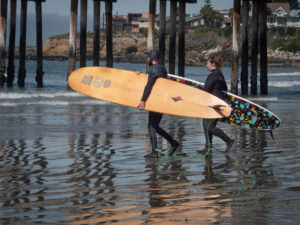 Even in Cayucos, near the pier, in the afternoon temps of mid-60’s, full wetsuits, booties and hoods were the norm.
Even in Cayucos, near the pier, in the afternoon temps of mid-60’s, full wetsuits, booties and hoods were the norm.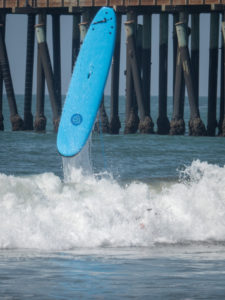
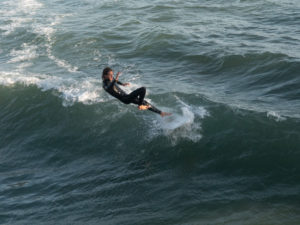
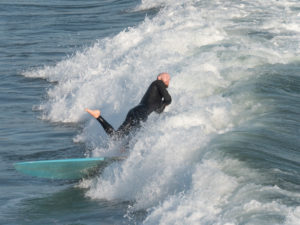
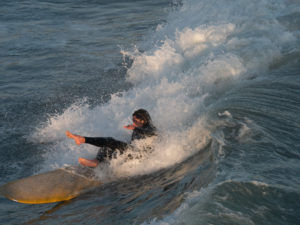
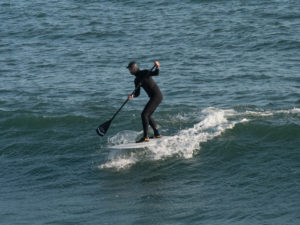
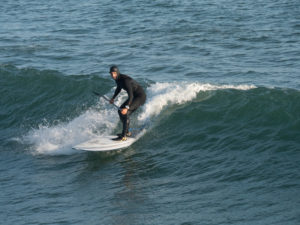
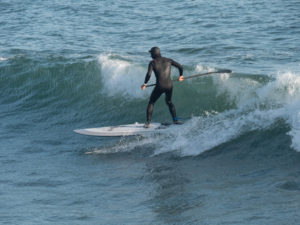
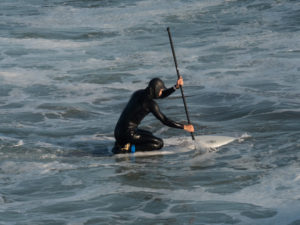
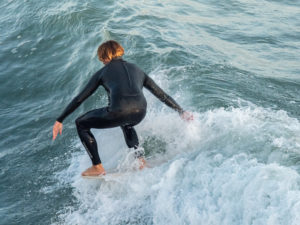
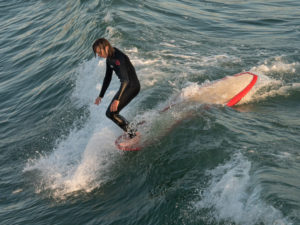
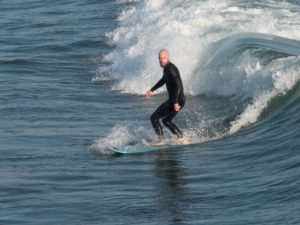
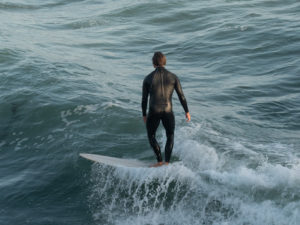
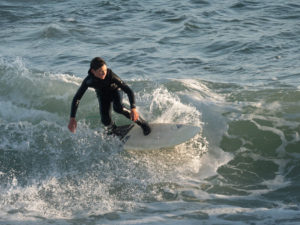 There were a couple of young guys out on their short boards working the waves.
There were a couple of young guys out on their short boards working the waves.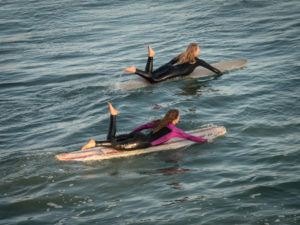 These two joined the mix late in the afternoon. They seriously looked like synchronized swimmers heading out on their boards with pointed toes at the ends of legs that were moving up and down in a rhythmic kicking motion timed to their arm strokes. The boys became less focussed once these two showed up. 😉
These two joined the mix late in the afternoon. They seriously looked like synchronized swimmers heading out on their boards with pointed toes at the ends of legs that were moving up and down in a rhythmic kicking motion timed to their arm strokes. The boys became less focussed once these two showed up. 😉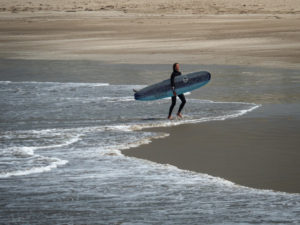 At the end of a session, walking out of the surf on a lonely beach shows the potential solitude of surfing.
At the end of a session, walking out of the surf on a lonely beach shows the potential solitude of surfing.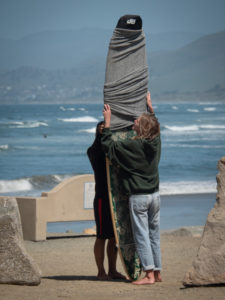 This was new to me. Covering a board before loading it up after a morning in the water.
This was new to me. Covering a board before loading it up after a morning in the water.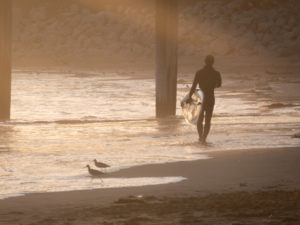 Back in Cayucos, the sun setting and a lone surfer calling it a day.
Back in Cayucos, the sun setting and a lone surfer calling it a day.